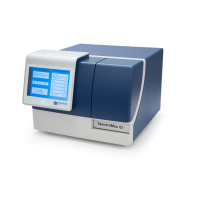SpectraMax iD3 Multi-Mode Microplate Reader User Guide
100 5054747 B
Background Correction on page 100
Detection Limit on page 100
Sample Volumes and Concentration of Reactants on page 101
Data Optimization on page 101
Background Correction
The light detected in a luminescent measurement generally has two components: specific
light from the luminescent reaction and an approximately constant level of background light
caused by various factors, including the plate material and impurities in the reagents. The
background can be effectively measured using blank replicates. Blanks should include the
luminescent substrate (chemical energy source) but not the luminescence agent (generally
an enzymatic group which makes the substrate glow).
A blank well contains everything used with the sample wells except the label and sample-
specific compounds. Do not use an empty well for a blank.
The blank sample reveals the offset underlying each data sample. This offset does not carry
information on the label, and is generally subtracted before data reduction is done.
For optimal results, Molecular Devices recommends that you run replicates for all blanks,
controls, and samples. In this case, the blank value that can be subtracted is the average
value of all blanks.
To help eliminate background luminescence from a microplate that has been exposed to
light, Molecular Devices recommends dark adaptation of the microplate by placing the
sample-loaded microplate in the instrument for several minutes before starting the read.
Detection Limit
The detection limit is the smallest sample concentration that can be measured reliably above
the blank. Determining the detection limit requires taking a number of blank measurements
and calculating an average value and standard deviation for the blanks. The detection
threshold is defined as the average blank plus three standard deviations. If the average
sample value measures above the threshold, the sample can be detected at a statistically
significant level.
The detection limit can be described by the following equation:
Det Limit =
3 Stdev
blank
std – blank
conc
std
where conc
std
is the concentration of the standard, StDev
Blank
is the standard deviation of the
blank replicates, and blank and Std are average values of the replicates for the blank and
standard wells.
Determining the detection limit for an assay requires multiple blanks to calculate their
standard deviation.

